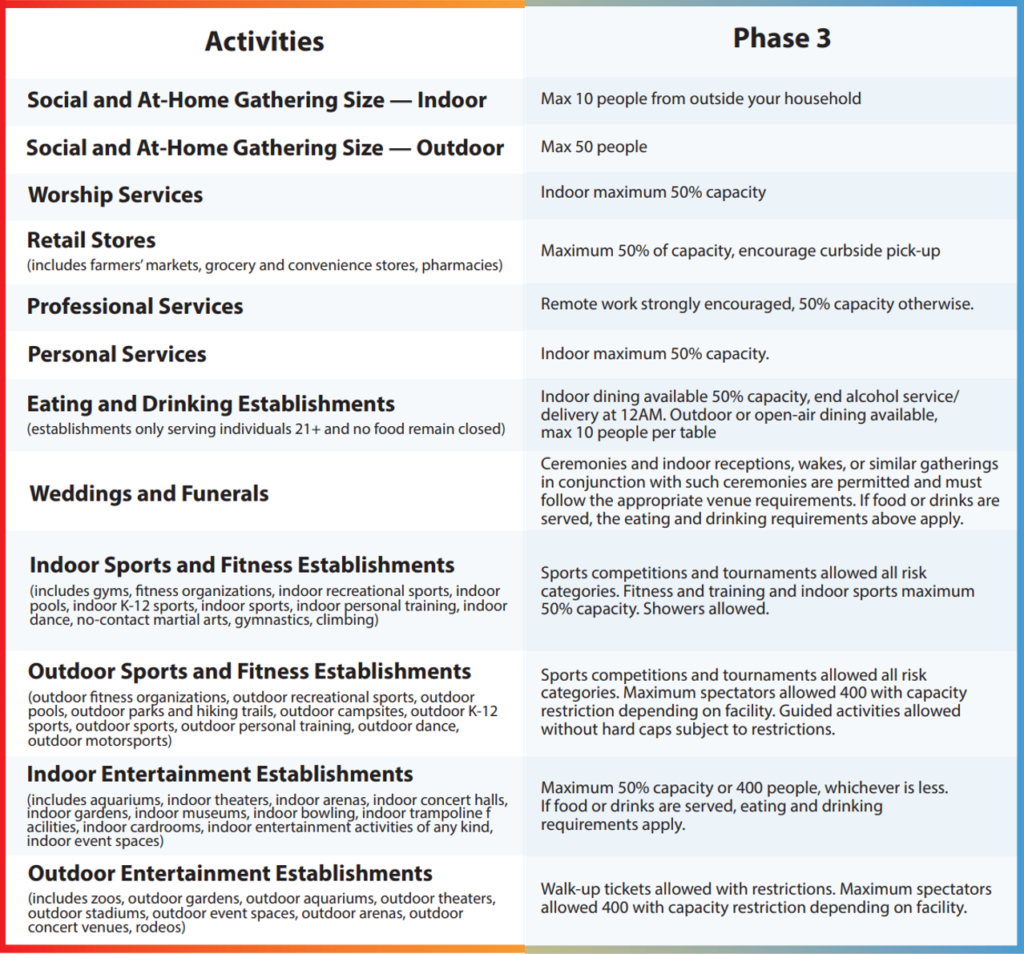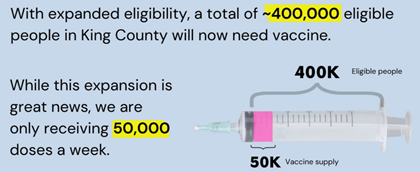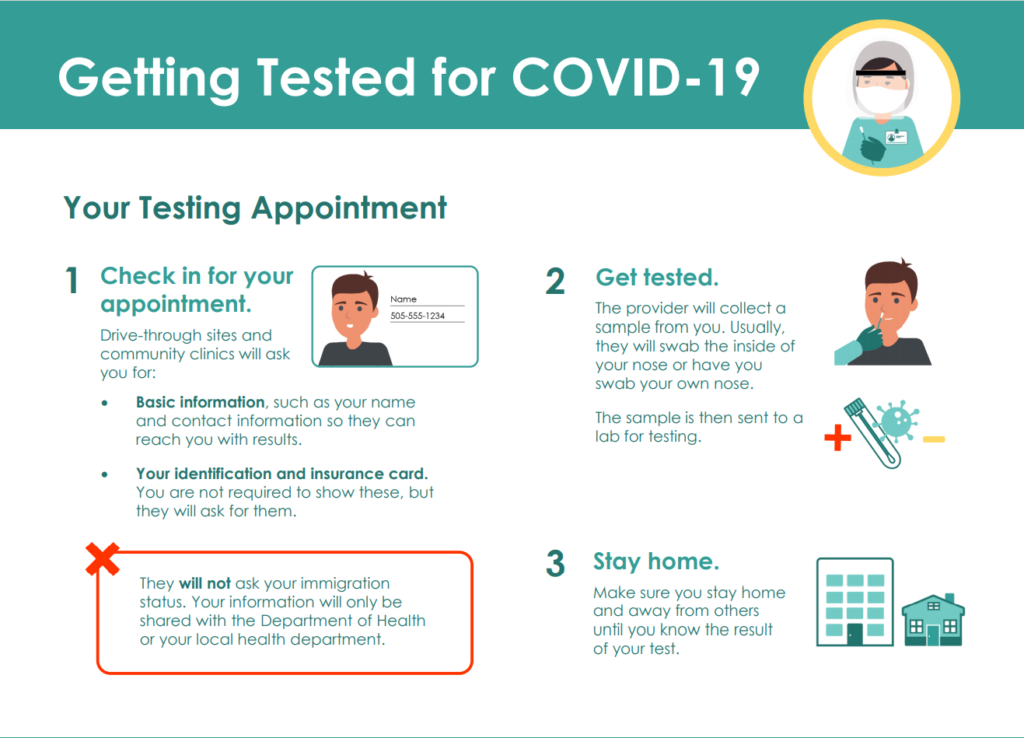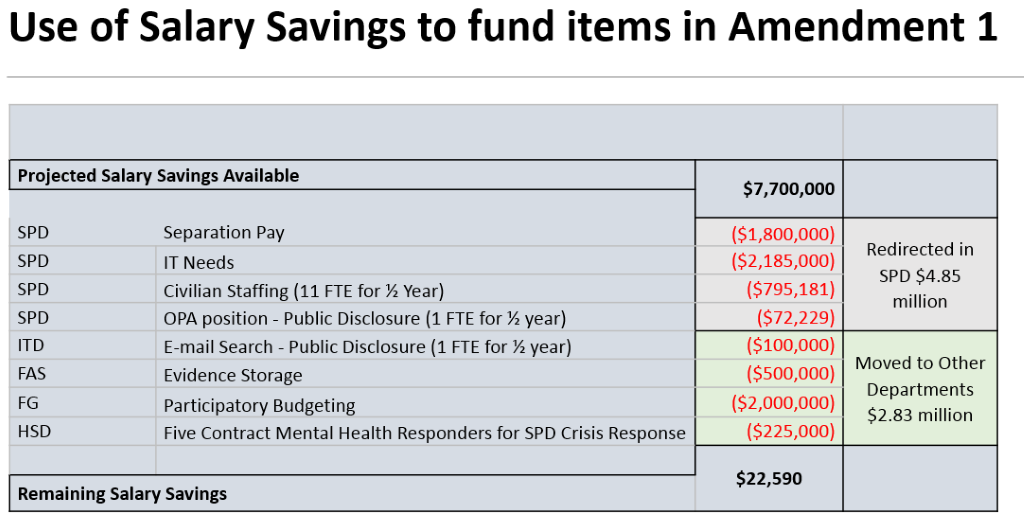Covid Updates: Phase 3, Keep Up Precautions, West Seattle Vaccine Site, Walk Up Vaccine for 65+, Testing
Phase 3: On Monday, Seattle and the entire state entered Phase 3 of reopening, according to Governor Inslee’s Healthy Washington Roadmap to Recovery. Allowable activities in Phase 3 are below and here. Public Health – Seattle & King County has a helpful webpage about reopening guidance here.
Keep Up Precautions: New cases of COVID are down from the extremes we saw over the winter – but still above the earlier “bumps” last spring and summer, with new and more contagious variants circulating locally. Cases are trending upward, with younger adults hit hardest (ages 20-40), and new cases up 31% in the last two weeks.
But here’s the good news: Masks work against the variants. Physical distance works against the variants. Good airflow and indoor ventilation are especially important, and handwashing and all the things that should be second nature to us by now still work against these variants.
“If we let down our guard, these variant strains will make us pay,” said Dr. Jeff Duchin, Health Officer, Public Health – Seattle & King County. “The upside is that we can take steps to limit the damage. The same precautions that have helped us drive down case counts in the past can also protect us from the variants, as long as we are diligent.”
Getting Vaccinated in West Seattle & South Park: If you are vaccine-eligible, there are several options for receiving your vaccination in District 1. But bear in mind: supply remains significantly less than demand, and you are likely to have to join a wait list and be persistent in your vaccine search. Supply is expected to pick up nationally in April.
Graphics from Public Health – Seattle & King County.
Here are some options to look for vaccine in District 1:
For those 65 years and older only: just show up between 9am-4pm Monday – Saturday at the West Seattle vaccination site at 2801 SW Thistle. No appointment required.
- A spokesperson from the Mayor’s Office provided this information: “SFD stopped turning away people 65 and over without an appointment because the number was small and they were typically the ones we were trying to help navigate our registration software anyways. We are prepared to adjust our approach if the number of 65+ walk-ups starts to increase, as that would require some operational changes.”
See if appointments are available at the City-run West Seattle vaccination site at 2801 SW Thistle.
Join the notification list for Seattle’s City-run community vaccination sites in West Seattle (2801 SW Thistle), Rainier Beach, or Lumen Field Event Center by clicking here or calling (206) 684-2489.
Check for availability at the other vaccine providers located in District 1 using this map:
Try this volunteer-built, searchable website that shows providers with available vaccine appointments.
Join the Seattle Fire Department’s standby list, if you’re able to travel quickly to receive leftover doses at the end of the day.
- We asked the Mayor’s Office to confirm this SFD list is still being used and received this response: “Yes, but rarely. We still maintain the standby list to use across all sites in case of emergency (like in an instance when we have significantly more leftover vaccine than expected).”
Take a chance on leftover vaccine doses at 2801 SW Thistle by showing up at the vaccination site at the end of the day, around 4pm Monday – Saturday. Be warned: Crowds of 50 to 100 people have been reported, and most go home without vaccination.
- A spokesperson from the Mayor’s Office said this when asked about the practice by the West Seattle Blog: “Generally, the Seattle Fire Department has around four-five doses left at the end of each day at our Rainier Beach and West Seattle vaccination hubs. We have found that residents in the area gravitate toward each site at the end of each day. If unused vaccine is available, SFD will vaccinate the oldest people in the line outside the site. SFD has found that this approach results in more older adults getting vaccinated through end-of-day doses than the standby list….”
- Check out this Seattle Times article describing how this works.
COVID-19 Testing: Early testing is important to help prevent COVID-19 from spreading to friends, family, and the community. If you have a sign/symptom of COVID-19 or were exposed to someone with COVID-19, please get tested. Find COVID testing locations in King County and more information about testing here.
If you have difficulty registering, call the King County COVID-19 Call Center at 206-477-3977 (open 7 days a week, 8 a.m.-7p.m.) If you need an interpreter, say in English what language you need.
You may have heard that after March 30th, testing will no longer be offered at the City-run site at SW Athletic Complex. I am inquiring with the Seattle Fire Department to understand how often the Curative testing kiosk at Don Armeni is used. Given that COVID-19 cases are increasing at a worrying rate, I am concerned about ensuring District 1 residents have easy access to testing on demand.
Meanwhile, here are the District 1 locations offering testing to the public:
Don Armeni Boat Ramp Curative Walk-Up Kiosk – Make reservations online
1222 Harbor Ave SW, Seattle, WA 98116
Self-serve, walk-up, oral sample kiosks at various locations throughout Seattle
Available, Mon-Sat, 8:00am-3:00pm
Neighborcare Health at High Point – Call for appointment: (206) 461-6950
6020 35th Ave SE, Seattle, WA 98126
Languages: Amharic, Amharic, Arabic, Cambodian, Oromo, Russian, Somali, Spanish, Ukrainian available onsite; interpretation available
Available: Monday-Friday, 2:30pm-4:00pm
Sea Mar Community Health Centers at South Park – Call for appointment: (206) 762-3730
8720 14th Ave S, Seattle, WA 98108
Languages: Spanish, Interpretation available
Available: Wednesdays 1pm-5pm, Fridays 9am-1pm
West Seattle Walk-up – Make reservations online
TESTING ONLY AVAILABLE UNTIL MARCH 30TH
2801 SW Thistle St., Seattle, WA 98126
Phone: (206) 684-248
Languages: Interpretation available including ASL and tactile interpretation
Available, Mon-Sat, 8:45am-5:30pm
West Seattle Bridge Closure, One Year Later – A Year in Review
Just over a year ago, in the early stages of the COVID pandemic, our lives were doubly upended when SDOT announced the closure of the West Seattle Bridge. March 23rd is a day those of us in West Seattle and nearby communities will never forget. The closure has resulted in suffering our in communities, for residents and businesses. It’s become more difficult to get to work, visit friends or relatives, and get to other parts of the city and region.
Let’s take a minute to review what’s happened since then, and consider what still lies ahead.
First of all, remember that it was not clear at the start whether the bridge could be stabilized, or would need to be demolished. SDOT declared a “Fall Zone” for potential evacuation for the areas near the bridge. Any potential failure could have affected the lower bridge as well.
Without the bridge, traffic patterns shifted quickly, even with reduced traffic overall due to the pandemic. There previously had been 21 lanes off the peninsula and across the Duwamish; now, there were only 12 lanes, with SDOT limiting access to the Spokane Street (lower) bridge to transit, freight, and emergency vehicles. Those on the north end of the peninsula lost their key access points; those to the south faced increased traffic.
To address the fact that significantly more traffic shifted to exit the peninsula via West Marginal Way SW and through the southern portions of the peninsula, SDOT moved quickly to install a temporary traffic signal at the intersection of Highland Park Way SW and SW Holden Street. This has helped to address the sudden increase in traffic and enhance road safety.
The Council moved quickly to adopt funding, approving first a $70 million interfund loan that I co-sponsored to fund immediate work, and later a $100 million bond sale. An additional $50 million is listed for 2022 in the SDOT’s six year capital budget adopted by the Council.
These funds have paid for:
- Work on the West Seattle Bridge
- Preventative work to ensure the lower bridge continues to function
- The Reconnect West Seattle program, designed to address the impact of the closure. While nothing can replace the sudden reduction in traffic lanes off the peninsula, there are projects that can assist with safety on roads, with cut-through traffic increasing, and on streets with increased use.
As part of the Reconnect West Seattle program, detailed Home Zone safety projects are proceeding in Highland Park, South Park and Georgetown.
SDOT determined 450 additional daily trips could be accommodated in the lower bridge, and expanded access to school buses, employer shuttles, and a limited number of additional users under a dynamic Low Bridge Access Policy including business use.
Later in the summer, informed by traffic monitoring and guidance from the West Seattle Bridge Community Task Force, access was permitted for all users between 9 PM and 5 AM.
After the West Seattle Bridge was successfully stabilized, the next question was whether to proceed with a repair or a full replacement. The West Seattle Bridge Community Task Force examined this a number of times, and a Cost/Benefit analysis provided high-level cost estimates and timeline estimates for different options.
The Cost/Benefit analysis showed a repair could be completed by 2022, whereas a replacement would take until 2026. In addition, a repair had a significantly lower cost. The Technical Advisory Panel expressed confidence a repair would last 30-40 years, and the Council’s consultant agreed with proceeding with a repair.
In late October, I advocated for a repair, noting “As the City Councilmember for District 1, I hear nearly every day from residents and businesses that are hurting. The sooner we restore bridge access, the better. That’s a premium value for me. Once social distancing ends or decreases, traffic and access issues will only increase.” In November, the Mayor chose to proceed with a repair.
During the summer, the Council placed Proposition 1 on the November ballot, to continue funding additional King County Metro bus service in Seattle. This will become more important as COVID vaccinations proceed, and traffic patterns get closer to pre-COIVD levels, as we pass through additional phases of Governor Inslee’s Roadmap to Recovery; the entire state entered Phase 3 on March 22nd.
I sponsored an increase in the ballot measure for funding allowed for “emerging needs” which specified responding to the West Seattle Bridge closure, and COVID, as well an equity amendment to allow routes in southern end of peninsula that cross city limits to receive greater consideration. Voters approved Proposition 1.
King County Metro developed a West Seattle Bridge Closure Transit Action plan with options for a variety of scenarios. In West Seattle Metro is operating 85% of pre-COVID service levels, though with significantly reduced capacity per bus due to COVID safety protocols. This week Metro will add service to Routes 50, 60, and 128, in response to crowding above COVID limits; additional service restoration is planned for September 2021. Metro is planning how best to do this, based on data and community input.
SDOT recently completed 30% design for the repair, setting a baseline cost of $58 million for repairing the bridge, with the timetable remaining mid-2022. 60% design is targeted for July, when there will be cost and schedule updates. Construction is targeted to begin in November. Federal approvals are needed prior to the commencement of construction.
Last week, the Council acted to accept grant funding to increase the total funds secured to $124 million. The Council and Mayor sent a joint letter seeking funding for a federal INFRA grant, and work to seek funding at the state legislature is ongoing.
For the lower bridge, I’ve advocated for other uses with SDOT, including for health care workers during the COVID-19 emergency; by time of day; for company shuttles; for school buses once the school year starts; for motorcycles; for patients in need of lifesaving medical treatment, for business access, and for general access in a phased manner for residents.
At the Community Task Force meeting earlier this month I asked SDOT when they will make a decision about bridge access on weekend mornings, since there appears to be clear capacity. SDOT indicated they are likely to bring an update to the next Community Task Force meeting in April after additional outreach to underserved communities.
Additional background information, reports and documents relating to bridge inspections and grant applications are available at SDOT’s West Seattle Bridge website.
Included there is a link to the 2014 HDR Report, which lists several potential causes for cracks that appeared in the bridge in 2013; a December Seattle Times article also includes relevant information.
SPD Budget Legislation Update
The Public Safety and Human Services Committee met for a third time to continue legislation reducing the 2021 SPD budget. At the March 23rd meeting, I introduced a substitute version that the committee voted 3-2 to adopt as the base version; the legislation remains in the committee at this time.
It’s important to note that this bill is not about funding for police officer staffing. The 2021 SPD staffing and hiring plan been fully funded since November. “Fully funded” means that the funds provided are sufficient to fund the hiring of all the officers SPD intends to hire in 2021.
This legislation was scheduled for consideration at the meeting of January 26, but was not heard due to time constraints. The legislation was then scheduled for a presentation on February 9, but was delayed until February 23rd at the request of the City Attorney’s Office, after the comments in early February of Judge Robart, who oversees the Consent Decree.
When introducing the bill, which would reduce the budget by $5.4 million due to funds overspent on overtime costs in 20120, I said when considering possible future modifications to the bill, that I would not be rigid and would consider additional potential spending needs.
The potential $5.4 million proposed reduction in the original bill is from funding available due to officers positions that are not expected to be filled under SPD’s 2021 staffing plan. We refer to this as “salary savings;” or funds that cannot be spent in 2021 on salaries because the positions are vacant and exceed the number of positions able to be filled in 2021. Council Central Staff estimates $7.7 million in 2021 “salary savings.”
Budgetary oversight and accountability are key elements of the Council’s work, across departments. There are often additional funding requests from SPD at the end of the year, which makes fulfilling the Council’s responsibility for setting budgets, and exercising fiscal oversight, considerably more difficult than with most other executive branch departments.
I invited SPD to present to the committee on March 9th regarding proposals they made in a January 25 memo, subsequent to the introduction of the legislation. The SPD presentation included new proposals for potential use of some of the $5.4 million proposed to be cut; new proposals that were either not proposed in the proposed 2021 budget or new proposals that reversed decisions made int the 2021 adopted budget. For instance, SPD has newly proposed hiring 11 civilian positions, thus reversing the Mayor’s proposal for the 2021 budget, in that her proposed budget proposal cut funds in the SPD budget by limiting 2021 civilian hires. SPD indicated these new investments could ameliorate the current staffing shortage in officers. I agree.
At the March 23rd committee meeting, I introduced for consideration a substitute version of the original bill.
The previous day, on March 22nd, SPD received a letter from the Monitor overseeing the Consent Decree that states:
The Monitoring Team asks that these questions be answered as expeditiously as possible, and prior to further actions by the City on the budget of the Seattle Police Department. Upon receipt of the analysis, the Monitoring Team will confer with the Department of Justice and advise the Court.
The letter requests SPD reply to questions about budget as it relates to compliance with the Consent Decree. Given the Monitor’s interest in the legislation, I proposed amending the legislation in committee, but not moving it out of committee to the Full Council.
The substitute proposal includes funding the investment proposed by SPD proposed in committee on March 9, in addition to $2 million to participatory budgeting, and enhances funding for public disclosure, evidence storage, and mental health crisis responders.
The civilian positions funded include four Community Service Officers (CSO). I co-sponsored the re-creation of the CSO program in the 2017 budget. CSOs serve to bridge the service gap on non-criminal calls for service and perform a variety of public safety-related community service and outreach work that does not require the enforcement authority of a sworn police officer.
Also included are crime prevention coordinators, public disclosure responders, and technology investments.
I proposed additional staffing for public disclosure response positions, as recommended by the City Auditor in his 2015 report; Interim Chief Diaz has noted the challenges SPD faces in responding to the high volume of public disclosure requests SPD receives. One position would be in the Seattle IT Department; SPD is the only department that has to respond to e-mail searches for PDR responsive emails, rather than having IT do it.
Also included is funding for evidence storage facilities, as recommended by the Inspector General; the Inspector General has found that SPD’s evidence storage facility is inadequate leading to improper destruction of DNA evidence and purging of evidence from an unknown number of homicide investigations. This funding would be in Finance and Administrative Services.
The substitute also creates 5 new mental health crisis responder positions in the Human Services Department, to assist police officers in responding to situations where there is an armed person in crisis, and potential danger to the public and officers.
The proposal provides $2 million for the participatory budgeting program, increasing the total to $32 million. Funds will be guided by the work of the Black Brilliance Research Project, which has recommended priorities including crisis response alternatives, violence interruption, harm reduction proposals, and community-based emergency services.
I moved the substitute version in committee, to set it as the baseline legislation before the committee. It was approved by a 3-2 vote. Because of the Monitor’s letter, I didn’t move to vote the legislation out of committee to the Full Council, while we await any updates from the Monitor and Court, per the Consent Decree.
The legislation also notes the Council’s intent that salary savings be used for staffing special events, including mass vaccination sites with an event staffing deployment approach that ensures, excepting security within facilities, prioritizing use of non-sworn SPD staff, so that sworn officers can be prioritized for patrol staffing and 911 response. In 2017 the City Auditor found “at many special events, SPD sworn personnel perform work that is primarily traffic-directing” and recommendation to “evaluate the traffic-centric special events work SPD sworn officers perform and consider using non-sworn personnel for some of it.”
In practice this would mean prioritizing use of parking enforcement officers (PEOs) where possible. PEOs are currently in SPD; in the 2021 budget Council voted to shift them to a new department, Seattle Community Safety and Communications Center, later this year.
Municipal Archives: Police Accountability in Seattle, from 1955 to the present
Over the past year staff of the Municipal Archives have worked on a history of police accountability in Seattle. Research focused on protests, committee meetings, public hearings, and other venues where Seattle’s residents have interacted with their government to request mechanisms for accountability. The result is a website with a timeline, an illustrated exhibit, a detailed narrative, and a bibliography. The goal of the site is to provide a window into how decisions were made in the past and to encourage more research on this topic.
This Police Accountability in Seattle page includes information from the City Archives dating back to 1955, and a Mayor’s Advisory Committee on Police Practices that met in 1955 and 1956.
Here are links to timeline, exhibit, and a history of Police Accountability in Seattle, 1955-2020, which is also available as a PDF file with source citations.
This history shows that the issues we are facing now are not new.
Thank you to City Clerk Monica Simmons and City Archivist Anne Frantilla and the other members of the Seattle Municipal Archives for their work on this.
Get Relief from Utility Bills
Seattle Public Utilities (SPU) and Seattle City Light (SCL) will help keep services on and offer relief to utility customers during the COVID-19 Civil Emergency in Seattle. Residential and commercial customers financially impacted by COVID 19 are urged to set up payment plans with either Seattle City Light or Seattle Public Utilities.
The Utility Discount Program (UDP) lowers Seattle City Light bills by 60 percent and Seattle Public Utility bills by 50 percent. To learn more about enrollment in UDP, call 206-684-0268 or click here.
Professional translation for City utility services are available when you call 206-684-3000. *Información en español * Impormasyon sa Tagalog * 中文資訊* Thông tin bằng tiếng Việt * 한국어 정보 * Macluumaad Af-Soomaali ah
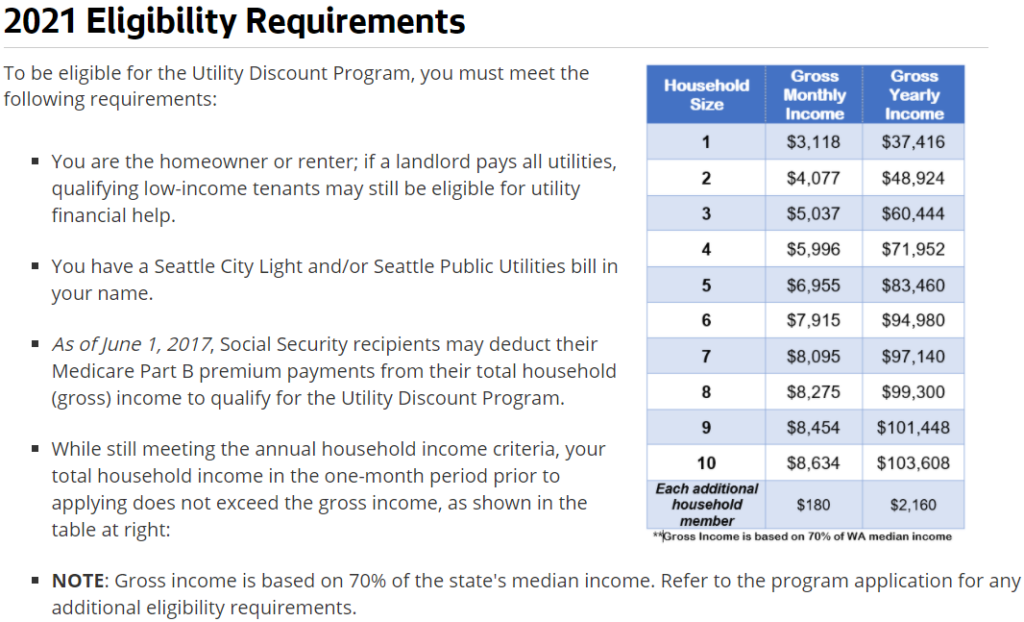
Stone Cottage Update
You may remember me writing about the Stone Cottage back on January 4, a community group had begun their fundraising to lift the cottage off the foundation and transport it to a temporary location as the property owner is beginning development.
On March 21 the group announced that they had raised enough funds to begin the moving process. You can read more about here.
The group continues to fundraise in order to executive the full plan to rescue, relocate, and restore the Stone Cottage, but the building will be moved this spring.
OEM 2020 Annual Report
In the Public Safety and Human Services Committee this week the Office of Emergency Management (OEM) presented their 2020 Annual Report. The OEM mission is to “partner with the community to prepare for, respond to, mitigate the impacts of, and recover from disasters.” To that end the Office is responsible for managing and coordinating the City’s resources in dealing with all aspects of emergencies.
Last year was a difficult year and the OEM was activated to manage several different emergencies, including: Covid-19, the West Seattle Bridge, Protests, Wildfire Smoke, and Election Day. The report gives a high-level overview of each emergency and how OEM managed them.
Like all of us, OEM had to adapt and manage a new “normal” of working at home. OEM had to leverage new technologies and adapt under difficult circumstances. I want to thank them for their steadfast commitment to the City and our residents.
One of the items called out in the Report – the All-Hazard Mitigation Plan – began with a survey late last year. In that survey 65% of respondents where “very concerned” about an earthquake. This leads into my efforts to addressed Unreinforced Masonry (URMs) buildings – these are buildings that are susceptible to collapse during an earthquake and pose a significant risk to loss of life. I’m working with the Executive to pass a resolution outlining next steps so that we can address these buildings as quickly as possible. The All-Hazard Mitigation Plan will culminate in the delivery of the Plan to Council which we expect to receive sometime in the Spring.



